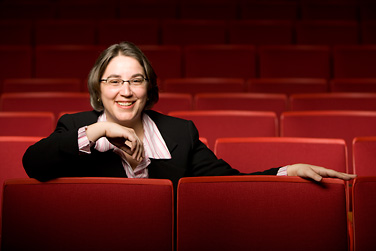Close Up
Studying country music’s view of women

Stephanie Vander Wel says music “gives us a richer understanding of history,” offering “a window to a more complex narrative.” Photo: DOUGLAS LEVERE
Ask Stephanie Vander Wel about female country singers and she'll take you all the way back to Patsy. Not Patsy Cline, but decades earlier to Patsy Montana, who in 1935, became the first female country artist to sell a million records with her song "I Want to Be a Cowboy's Sweetheart."
Vander Wel, an assistant professor in the Department of Music, College of Arts and Sciences, connects the roots of country music during the early 20th century with the white rural and working class migrating across the country. Her focus on Montana comes from her interest in how country music has demonstrated representations of femininity, class and race during the historical context of migration out of the south.
Vander Wel shed some light on Montana and the freedoms of the West during a recent session of the Humanities Institute’s New Faculty Seminar Series. Vander Wel's talk stemmed from her doctoral dissertation on country music, gender and migration at the University of California-Los Angeles.
Montana got her start on “National Barn Dance,” a national radio program broadcast by Chicago’s WLS that was the precursor to the “Grand Ole Opry” in Nashville. According to Vander Wel, Montana's rise in popularity contributed to the sense of female autonomy during a complicated decade attributed to the Great Depression and the renegotiation of women's roles in the workforce. Vander Wel believes Montana asserted a dignified rural identity that served as an escape from the hardship of daily life. “She sings a song, ‘The She Buckaroo,’ where she's a man-hating lassie who can out-ride, out-rope any cowboy around," says Vander Wel.
Vander Wel grew up in a suburban setting in Washington State with traditional gender roles, but her own background has personal ties to a cowgirl's life. Her grandfather, an actual cowboy, owned a farm in Oregon and she spent her childhood summers in a rural, yet liberating landscape, where she rode horses and fed cattle and performed other chores on the farm next to her male cousins.
In college, Vander Wel gravitated toward women’s studies and was interested in the grand narrative of the 20th century in regard to gender ideologies—from women in the domestic sphere to "Rosie the Riveter" during World War II, and then women reverting back into domestic positions until the second wave of feminism during the 1960s. The matriarchs in Vander Wel's own working class family never adhered to these models. And her grandmother's role on the family farm showed that she worked just as hard at manual labor as her grandfather to make sure everything ran smoothly.
Since history is typically narrated from a white middle class perspective, it doesn't always accurately portray the nuances of history as different models of identity, Vander Wel says. She hopes to broaden the historical narrative through her study of music by also considering class and race in a more complicated manner. "Music is really good for this. It gives us a richer understanding of history. Music offers a window to a more complex narrative."

Reader Comments